Nature & Environment 2004
Climate change
Our global climate is warming up. The average temperature has gone up by 0.6 degrees Celsius during the 20th century, and 1990-2000 was the warmest decade ever measured. Nature has started to respond to these changes. Trees are blossoming earlier during the season, animals are migrating, and sea levels are rising.
Global warming
Over the last 10 to 20 years an increasing number of observations worldwide have delivered evidence that our global climate is changing markedly. The temperature is increasing, precipitation quantities and patterns are changing, and extreme weather with flooding and storms is becoming more frequent (Intergovernmental Panel on Climate Change (IPCC) 2001).
Since pre-industrial time, a warming of the Earth's surface by
0.7 °C has been observed; a trend which is unusual compared to the scope and speed of natural climate variations observed within the last 1000 years. Globally, the 1990s were the warmest decade ever
registered since records began in 1870, and, in Denmark, the temperature has risen by 1 degree since 1870. 1990 and 2000 were the two warmest years ever measured in Denmark. Globally, 1998 was
documented as the warmest year, with 2002 and 2003 following in step.
The magnitude and speed of changes in climate in future is still uncertain. It depends on how well we succeed in limiting the global emission of greenhouse gases. Moving from observations backwards in time to future scenarios toward the year 2100, our conclusions become increasingly hypothetical and have to be based on ever more complicated model calculations.
However, today it is commonly accepted that climate change caused by humans has consequences for virtually all of the Earth's ecosystems; the world's food production; the accessibility, quantity, and distribution of freshwater around the globe; human health; and the foundation for social development and economic growth in many countries. Thus, the global warming which has taken place over the past 20 to 30 years is already measurable in the distribution and population frequency of many plant and animal species. In Europe, it has been observed that plant species are spreading northward as a consequence of the increased temperatures. Thus, climate change increases the pressure on ecosystem functions and on valuable nature assets.
18 POLLEN-SEASON ON-SET AND QUANTITIES
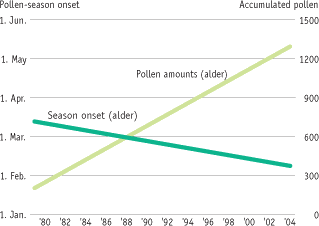
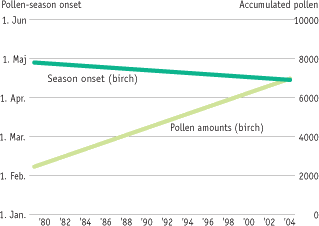
Source: Danish Meteorological Institute (DMI)
The graph shows the effects of climate change in Denmark, expressed by the beginning of the pollen season and pollen quantities (development trend). It appears that the pollen season has changed significantly since pollen counts began in 1977. The season starts earlier, and the quantities of pollen have increased. The greatest change in terms of the beginning of the season concerns early pollen from alder, from around 12 March to 19 February. The change for birch is somewhat more modest - from around 23 April to 17 April.
The reason for this shift towards earlier pollen seasons is that the weather, especially in the spring months, has been significantly warmer in recent years than when pollen counts began. Annual pollen quantities (the sum of the daily pollen counts) have increased significantly - generally speaking by a factor of 2 to 3 during the period. The general increase can be one explanation for the observed increase in the number of people allergic to pollen.
The greater quantities of pollen may be partly due to the increase in temperatures during the period, as higher temperatures usually lead to better growth conditions.
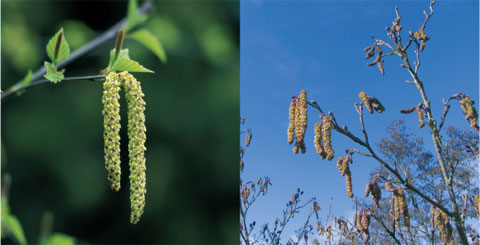
Climate change in Denmark - examples of impacts on nature
The Danish climate is getting warmer and in future we can expect a warmer, more humid and windier climate with more storms and more frequent periods with precipitation. The mean temperature in Denmark is now about 8°C; an increase of 1 degree since 1870. During the last century, annual precipitation has gone up by 110 mm to around 750 mm (Danish Meteorological Institute (DMI) 2003).
For a number of the IPCC's emission scenarios, Denmark's Climate Center under DMI has calculated the expected changes in Denmark's climate over the next century. For Denmark, the development toward 2100 shows an increase in annual precipitation of 10 to 20 per cent, most markedly in the winter season, and, thus, showing a clear trend toward a wetter winter climate. For the summer season, the trend is toward longer periods without precipitation and, thus, toward increased risk of droughts. The annual average temperature will be 3 to 5 °C higher than today; an increase which will apply equally for summer and winter, however with greater increases in night temperatures.
Wind conditions will also change. Westerly winds will prevail more frequently in future. At the same time, there will be a moderate risk of increased storm activity over Denmark and adjacent waters, both with regard to frequency and intensity.
If the temperature increases by 3 degrees, the natural northern limit for many plant and animal species' natural habitats will move 300 to 400 km to the north. Many species will have difficulties reacting to the fast changes by moving (migration) or by adjusting physically to the changes in conditions (genetic adaptation).
Coastal areas
The Danish coastline has a total length of about 7,300 km. How many kilometres are threatened by storm flooding or by increased water levels and storm activity in general is uncertain. Roughly speaking, the vulnerable areas are those parts of the country which, geologically, consist of raised, former seabed with Stone-Age and marsh sedimentations (approximately 4,300 km²), as well as dammed-in areas which are secured by dikes. Some dikes protect urban areas, e.g. the marine dikes in the Wadden Sea outside the cities of Ribe and Tønder, others primarily protect farmland, recreational areas with or without buildings, or coastal wetlands such as the Wadden Sea.
The marine environment
According to DMI's projections of climate in Denmark, sea temperatures in the seas around Denmark will increase by 3 to 5°C in the years toward 2100. An expected increase in sea temperatures will prolong the growth season of marine phytoplankton, and it will increase the marine ecosystem's general productivity, which means it will also increase the catch potential for fisheries. An increased water temperature in the North Sea will also entail the northward migration of southern species. This phenomenon has been observed already for benthic animals around the British Isles over the past 50 years, during which the ratio between warm-water and coldwater species within the group of zooplankton has shifted. In Danish marine waters, species such as mullet and rockfish are being observed more and more frequently, although these species normally prefer a warmer climate.
Forests
Increased storm activity, including more frequent storms and more severe storms, will be one of the negative consequences of a changing climate. It will mean greater risk of windfalls in Danish forests. As the 1999 storm evidences, the storm damage may be extensive. This is because a great part of the Danish forest cover is old stands of Norway spruce; a tree species not particularly resilient to high wind speeds. Denmark is placed centrally in a vegetation belt of temperate deciduous forest. In the case of moderate, future climate change, a majority of existing tree species will be able to persist in Denmark. Norway spruce, however, may be the exception. Norway spruce is naturally occurring in regions with cold winters and the species has already shown signs of poorer health in periods with warmer winters. According to a forest inventory in 2000, Norway spruce makes up about 27 per cent of the forest cover in Denmark. Moreover, in terms of area it is the most important tree species in forestry in Denmark.
In several European countries forests have been observed to be growing at a faster rate than previously. The marginal growth increment of individual tree species has increased considerably due to increased CO2 in the atmosphere and longer growth seasons, and also due to increased depositions of nitrogen and more intensive forestry. The expected climate change will enhance growth, particularly of those species which have their northern tree line in southern Scandinavia. Advantages for these species may, however, be limited by less precipitation during summer and increased risk of drought.
Plants and wildlife
The warming of our climate over the past 20 to 30 years has influenced the distribution and number of many plant and wildlife species across the globe. In Europe, many plant species have been observed further north than their original habitat due to rising temperatures (EEA 2004). Monitoring of the flowering season of plants in botanical gardens throughout Europe has shown that the growth season has increased by 10 days from 1962 to 1995.
In Denmark, the growth season, i.e. the period from leafing foliation to leaf drop, has been prolonged by 2 to 3 weeks and is expected to increase further. A longer growth season will increase plants' growth and productivity for species where the temperature is a constricting factor, and will lead to changes in the competition parameters and species distribution within natural ecosystems.
A warmer climate in Denmark will make it possible for southern plant and wildlife species to immigrate. The extent to which this may take place in practice depends on the barriers such species will meet in the form of farmed fields, urban areas and road infrastructure - barriers which are fairly easy to overcome for plant species whose seed spread via the air, or plant species that spread in ditches along roads. An example of the latter is wood-small reed, which is a southerly species now growing more and more commonly in Denmark. Indigenous species which have their natural southern habitat line in southern Denmark might disappear altogether because they are not strong enough to withstand the competition. One such plant species naturally belonging in the north is dwarf cornel.
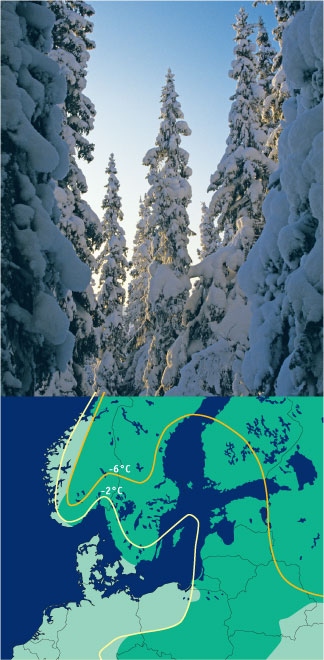
The distribution of Norway spruce
Norway spruce requires cold winters and its natural habitat roughly follows a temperature line for January of -2°C. If the temperature rises e.g. by 4°C, the tree line for Norway spruce might move to the present -6°C line. Note that Denmark is already outside the present natural area of growth for Norway spruce.
(According to: J. Bo Larsen).
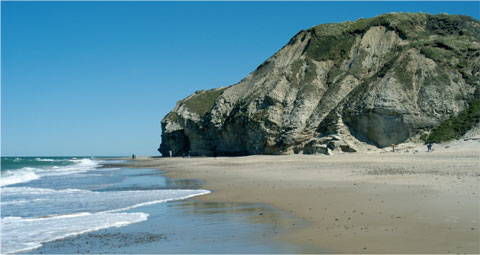
Threats to the coasts
Increased coastal erosion
Assumed sea level rises of 50 cm up to 2100 will increase the water depth locally and trigger or accelerate costal erosion which will exacerbate the retreat of the coastline. The west coast of Jutland between the towns of Hvide Sande and Thyborøn may retreat by up to 60 to 70 metres, if the erosion is not compensated by more beach feeding (Danish Academy of Technical Sciences (ATV) 2003).
Increased risk of storm flooding
Along Denmark's inner coastline, incidents of tidal flooding, which today are rare, will become commonplace following even slight increases in water levels. Changed wind patterns alone will mean that what today is a 100-year incident will become a 50-year incident, meaning the maximum water level occurring on average at 50-year intervals. If a sea level increase of 50 cm is added to this scenario, incidents which today are 100-year incidents will in many places happen annually. Hereby the risk of flooding increases, and, consequently, so will the need for adjusting the safety level for the about 900 km of dikes along Denmark's inner coastline.
Increased risk of flooding
More storm activity in combination with rising sea levels increases the risk of storm flood incidents s and flooding of still larger land areas. A sea rise of 0.5 m, for example, will reduce the present safety level of 500-1000 years for the dikes around Thyborøn to 50-100 years, and will in time necessitate reinforcement of the dikes if the safety level is to be upheld.
The Wadden Sea under threat
The Wadden Sea including the salt meadows along the southern part of the Jutland west coast is an example of a wetland area of international importance for migrating wading birds, which will be seriously affected by general sea level rises. Its location outside the dikes means that the salt meadows and the tidal flats are obstructed from following the coastline as it retreats inland and the natural area as we know it today will disappear.
Source: National Environmental Research Institute (NERI), Miljøtilstandsrapport 2005 (The State of the Environment in Denmark 2005). Danish Academy of Technical Sciences (ATV) (2003)
Version 1.0 December 2005, © Danish Environmental Protection Agency